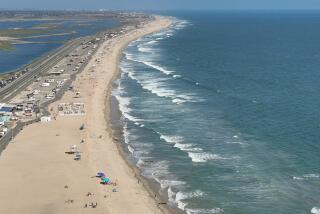Visions of Green Drawn in Sand
- Share via
Kent Trollen wasn’t offended that the most often-asked question from spectators marveling at the sand sculpture his team spent nearly two weeks building was, “What is that?”
Actually, it delighted him.
It gave Trollen the opportunity to remind those attending the Seal Beach Sand Castle Festival on Sunday that unless they shape up their act, the planet will face the grim future presented in his sculpture.
The 100-foot-long sculpture depicted a recycling machine in the year 2517--the only hope for cleaning up an Earth that has been completely trashed by garbage, according to Trollen’s written narrative for the piece.
The sculpture showed the giant starship-like machine sucking in tires, cans and other trash at the mouth of the San Gabriel River and transforming them into flowers. Trollen explains that this is happening at a time when humans, overwhelmed by trash, have long since fled the planet but returned after burying the rest of the galaxy in trash too.
“This is meant to be a slap in the face to people,” said Trollen, principal of Sandcastles Unlimited of Seal Beach, a company that builds sand sculptures across the country for private functions, corporate events and just for the fun of it.
The Space Age sculpture--built by a team of 54 people with the help of earth-movers and a high-loader--set the tone for the festival, which was organized by the local Chamber of Commerce to promote beach cleanup
The past few years have been tough on Seal Beach, with raw sewage contaminating the water and household trash washing onto the beaches through storm drains. So this year’s festival included the traditional sandcastle contest with an environmental twist.
Some of the contenders took their cues from Trollen--whose Space Age sculpture was a demonstration project--and built castles around an environmental theme.
“This is an octopus picking up trash,” said Fred Moore, 46, of Seal Beach as he stood in front of the sculpture built by him and his neighbors.
A couple of sculptures down was a scene with a bizarre, mutated creature crawling through what looked like the apocalypse. A caption carved in the sand explained: “Lost your city to trash.”
Peppered among the sculptures were booths where children played games with a clean-up theme.
“I did it all by myself,” said Willemina Freiberger-Inskeep, 4, with fishing rod in hand.
“I cleared out all the garbage.” She was playing a game run by the Orange County Sanitation District that involved fishing garbage out of a pond full of fake fish and plants.
The younger boy next to her didn’t do as well. He became a little confused and just threw his plastic dinosaur into the pond.
Near the festival entrance, a group of young girls rubbed their fingers along rows of slimy kelp and recoiled a bit when Scott Smith, a high school teacher and Orange County Coast Keeper volunteer, informed them that the plant is a key ingredient in ice cream.
That was enough to get the girls moving to the next table, a display of how urban runoff makes its way from the San Gabriel Mountains all of the way down to Seal Beach.
But the kelp kept some of their parents intrigued.
Smith explained that his students grow it on small tiles in water tanks in his classroom. Professional divers then take the tiles and place them in the water at Crystal Cove State Park in areas where kelp is critical to the ecosystem. Pol- lution has killed off much of the kelp that once grew there.
“The students go to the beach and see it growing again,” Smith said.
“They say, ‘Hey, that’s my kelp.’ ”



